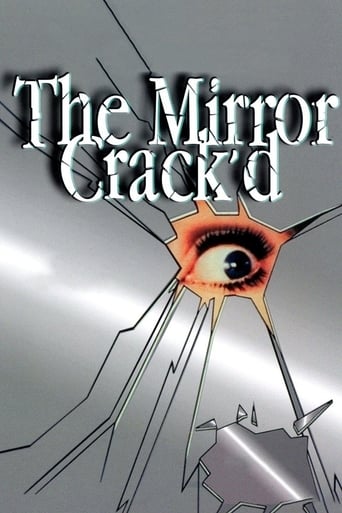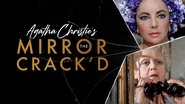Irie212
My favorite film version of "The Mirror Crack'd" is this one, from 1980, but only because of my great admiration for Angela Lansbury, who plays Jane Marple. The same story was also adapted twice for British television, with Joan Hickson in 1992 and with Julia McKenzie in 2010, and a third time in India under the title "Shubho Mahurat." I have seen, and can recommend, both English versions, particularly the 2010 film, which has terrific performances by Lindsay Duncan and Joanna Lumley, and also wisely includes an important character who is left out of the Lansbury version, a woman named Margot, played by Charlotte Riley (more on Margot below). Other reviewers have commented on the all-star (and aging-star) cast of this version: Rock Hudson, Elizabeth Taylor, Kim Novak (each of whom would make only two more movies after this), and Tony Curtis (in the final quarter of his 96-movie career, and blessed with a strong, wise-cracking character). None of the four were consistently great film actors, in my view, but they were pros by 1980 and they handle this material well, especially in the scenes they are lucky enough to share with the divine Edward Fox, who plays Dermot Craddock, a Scotland Yard inspector and also Marple's nephew.This review is less about the movie, which is an intricately constructed murder mystery, baffling and thus satisfying. Instead, I wonder about one particular aspect of the work as a whole: how the audience is meant to feel about the murderer, her motivation and her justification. (The spoiler alert is serious because I just revealed the murderer's gender, and will soon specify her name.) I suspect I'm in the minority, but if the story had continued, putting her on trial, I'd have convicted her without a second thought, in spite of all the admiration and sympathy being heaped on her by the other characters and, I think, the creators, perhaps including Agatha Christie herself (I haven't read her original book).The murderer is the central character, Marina Rudd (Elizabeth Taylor), an actress who is trying to make a comeback with the help of her director/ husband (Rock Hudson). She is presented as a fragile character, barely holding herself together as the location shoot begins. The murder happens at a party they host, where she is introduced to various people including a flibbertigibbet named Heather-- an ardent fan whom she had encountered once, several years earlier, during the war. Within minutes of politely listening to her prattle about that first brief meeting, Marina realizes that Heather was the person who had accidentally exposed her to German measles while she was pregnant, a pregnancy that had not been easy to achieve, and indeed had followed the adoption of three children (one of whom is Margo, from the McKenzie film version, a daughter Marina so neglected that she doesn't even recognize her as an adult). Because of exposure to rubella, Marina's son is born with a neurological birth defect, the severity of the which is not specified; whatever it was, however, was sufficient to overwhelm Marina, who abandons him to a mental institution, has a nervous breakdown, and tanks her career. Now, meeting the innocent vector of the virus, her immediate response is murder. Marina poisons her within minutes of meeting her.It seems, as I said, from the dialog and the treatment of Marina Rudd by other characters, that we are meant to have considerable sympathy for her. Well, count me out. I was appalled at how monumentally self-centered she was-- first, to abandon her disabled child; and then decades later to murder the woman who had, in all innocence, exposed her to the rubella virus; and finally to murder one of her staff, Ella (Geraldine Chaplin), because she *might* have witnessed the poisoning. (A precis of the original Christie novel informs me that Marina also murders the butler because he, too, *might* know too much. This Lansbury version doesn't venture into the neglect of the three adopted children.)There is no arrest, no trial. Marina either commits suicide by overdose, or she is assisted in that by her husband, or possibly, her husband kills her with an overdose in hope of sparing her the charge of multiple homicide. It is ambiguous. But I do wonder, if she had survived and there were a trial, would you want the jury to convict her? I know I would.
elshikh4
It is so elegant picnic, through elegant places, and among elegant people. You're accompanied by lovely music, serenely-colored cinematography, and sedate directing. This is my kind of "afternoon", "calm down", "have a nice time", movie. Yet it has more to it. More of what can exceed the eye enjoyment to the mind enjoyment.Talking about the eye enjoyment; Taylor, Hudson, Novak, Lansbury, Chaplin, Fox, and Curtis are all here and doing well. I believe it wasn't the tradition back then with movies based on Agatha Christie's novels, rather it was another battle in the war between cinema and TV since the late 1950s, where mobilizing many stars was always a good weapon. I love to think sometimes that the good the TV reaches, in terms of quality and popularity, the more these star-studded movies are made. Notice well that the 1970s was the golden age of the "crime solvers" shows on TV, thus gathering all star cast for a crime solver movie at the time was more like "we can fight fire with fire" from the cinema side !Lansbury was wow as Miss Marple. Maybe that what made her win the role of Jessica Fletcher, in the TV show (Murder, She Wrote) 4 years later, which was less connected to Miss Marple and more Agatha Christie-like. It lasted for 12 seasons for some reasons; one of their first is Lansbury's exceptional charm. However, pardon me all, Elizabeth Taylor stole the show this round. While being not one of my favorites, I have to admit that Taylor showed some acting muscles as the unsettled, yet deeply wounded, movie star Marina Rudd. Still the scene of interrogating her by Edward Fox's character is the top of this movie, one of the evidences why she's considered an acting icon, and an interesting intro to the movie's intellectual core; which was presented somehow in its title.Now Taylor plays an actress who acts on everybody in real life as a victim, while being the actual killer. At that specific scene, she was trying to resist the investigator by her only weapon : acting. However, he exposed every try with his movie culture and certain love for that star. The original "crack in the mirror" happened when she couldn't resist anymore, and the divider between her played character and real self collapsed; thus she could see the criminal in herself, not the victim, which pushed her to committing suicide eventually. Throughout the movie there were many other cracks, between fiction and reality, however deeper. One when you watch the stars of the 1950s, after passing their prime, making a movie – in the 1980s – where they act as stars in the 1950s, after passing their prime, trying to make a movie ! Remember the hints about Hudson as a has-been, Taylor as unstable.. these are wicked cracks in the movie's mirror for sure ! (At least while the 1950s movie within the movie didn't complete, the movie of the 1980s did!).Another cracks, not less wicked, when Hudson and Curtis, while playing film director and producer respectively, speak openly about some of the movie industry's facts, such as "the director gives the producer an ulcer", "the matter of which actress's name will be written first is defined by which one sleeps with the producer!". They're shown as rude jokes, but maybe there is a mirror crack there, where we watch not a tame image of something, but the real deal ! Surprisingly the biggest "mirror crack" this movie has is the fact that it's nearly based on real story. As I read, American film star Gene Tierney, while pregnant with her first daughter, contracted German measles after a performance she did to the American soldiers in June 1943. Because of her illness, her daughter was born disabled. Tierney met that fan later, and learned that she had sneaked out of quarantine, while sick with German measles, to meet the star after her performance for the American soldiers in June 1943. Christie inspired the incident, showing maybe the scariest revenge a star had on an importunate fan.Actually cinema, as an art and world, had enough share of satire in this movie's conscience. It is shown as a devise which doesn't tell right history but makes its own version of it; e. g. changing the historical fact of what Queen Mary's guards wore as long as it didn't please the director (!). Not only this, you can powerfully touch a darkness that the cinema's glossy world contains : e.g. 2 stars smile for a photo while insulting each other whisperingly, a seemingly nostalgic conversation between a star and her devoted fan turns into a murder, a joyful party that contains a murder done in so cold blood.. etc. It's the main smart irony here : fiction vs. reality, shapeliness vs. ugliness, or simply the image reflected in nothing but burnished yet cracked mirror.That itself is pictured brilliantly. While the image is smooth, colorful, and bright, we have – in the same time – a fan who deformed a star's baby, a star who killed her secretary, a producer who tried to kill his wife, and a star who killed her fan, then herself at the end. The serene image, a mark of director Guy Hamilton's movies, represented the catchy element that it used to be, and – also – a fine contradiction with the disturbing events, as if all of that beauty is a mask to cover the beast, which consolidated the movie's both artistic and intellectual personality.So, as you see, I enjoy this movie, and not only for its good mystery, stars, and image. It does have more to it. That's why it's one of the best Agatha Christie's adaptations. In most of the other adaptations you may find nothing else good mystery, stars, and image !
facebook-432-357272
Usually, when a movie made in Britain cast characters from America they usually select fellow Brits for the parts even though their American accent is pretty bad and stereotypic. In this case, however, actual Americans or longtime transplants made their way into the respective roles. As a result, things turn out rather bad just from the drag factor of the Hollywood trained actors' performances. Lacking, as they do, the stage training typical of their British counterparts, they merely bring down the whole performance to their own tediously pedantic level. Lansbury's Marple, seems less the cerebral type and more a throwback to the music hall tradition. Too many years of Sweeny Todd, perhaps. More likely, just plain bad direction from a hack hired by a producer without a clue.
bkoganbing
Lord Brabourne who produced The Mirror Crack'd as he did a few other films adapted from Agatha Christie's work was lucky to have produced this at all. He was the son-in-law of Lord Louis Mountbatten and when the IRA blew up the yacht they were on, Brabourne's mother and son were killed on the vessel as well as Mountbatten. Brabourne, his wife and a younger son survived. This all happened a year before The Mirror Crack'd filmed and was released.This film is right in keeping with the high standard of pictures Brabourne made of Christie stories like Murder On The Orient Express and Evil Under The Sun. As the story involves an American film crew over in Great Britain in 1953 Brabourne was able to get a quartet of top Hollywood names in support of Angela Lansbury as Jane Marple.Producer Tony Curtis and Director Rock Hudson are collaborating on a film about Mary Queen of Scots that will star Hudson's wife Elizabeth Taylor in the title role. Curtis's wife Kim Novak plays what would be billed as a cameo in the film as Queen Elizabeth. Taylor and Novak are rivals in the tradition of Bette Davis and Joan Crawford and get off some truly bitchy lines at each other. Maureen Bennett who is one of the villagers and who met Taylor years ago in passing when she was a WREN and Taylor was entertaining troops is poisoned at a gathering of the villagers and the film crew. Someone spiked Bennett's daiquiri and who could possibly want to murder this ingenuous fan. Later on Hudson's secretary and girl Friday and trenchant observer of the whole Hollywood scene Geraldine Chaplin is also poisoned when her inhaler is similarly spiked. When Lansbury figures out the who in the film it all becomes deceptively simple. The motive however is an incredibly complex and obscure one involving a trivial passing incident that brought to life a great tragedy suffered by one of the visiting Americans.The film is a reunion of sorts with Hudson and Taylor as co-stars of the classic Giant from the Fifties, a personal favorite of mine for both its stars. Also back in those days Rock Hudson and Tony Curtis were both the leading contract stars at Universal studios, but they never starred together in anything. They did appear in Winchester 73 as featured players but had no scenes together. I really liked Curtis the best in this film with him doing a wonderful satire of Darryl F. Zanuck in the producer part. I'm sure Agatha Christie must have met Zanuck sometime because she had him down great and of course Curtis knew him as well.Definitely The Mirror Crack'd is a must for Agatha Christie fans and for fans of the stars. And considering what its producer went through we are lucky to have it at all.







